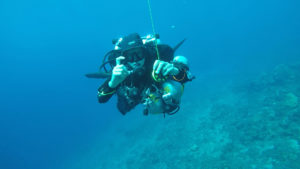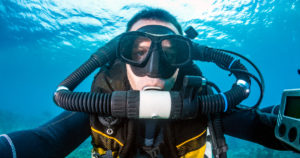In this installment of our tech-diving ABCs we’re looking at the letters Q through T. And while there are many more considerations to technical diving than the 26 letters of the alphabet can cover, we hope this might inspire you to delve a bit deeper into the world of tech. Check out the ABCDs, E through H, I through L and M through P as well.
Q is for Questions

We generally prepare more thoroughly for technical dives than recreational dives. Part of this preparation is meant to clear up any inconsistencies ahead of time before they lead to confusion. However, even the best preparation and briefing cannot cover everything and that’s why one of the hand signals we use most frequently is the question mark — a diver’s index finger bent into a shape resembling a real question mark. And if hand signals aren’t enough, then we can write in underwater notebooks or on slates. In fact, those planning a complex dive often take the time to develop a set of pre-planned phrases that they can use in a number of situations they are anticipating.
In technical-diving courses, asking questions is key for both the instructor and the student. The instructor will be checking the students’ understanding of what he or she is teaching. Students, on the other hand, must ask questions to ensure they are getting to the bottom of things. Letting things wash over you and hoping to successfully complete the course or any subsequent dives without understanding can be dangerous, so don’t be shy.
R is for Rebreather Diving

Rebreathers allow for bubble-free diving by recycling the diver’s breathing gas. In the process, a scrubber material filters out our carbon dioxide — a byproduct of our respiration — and oxygen metabolized by the diver is replenished.
Closed circuit rebreathers (CCR) maintain a constant partial pressure of oxygen in the breathing mix. That means the diver is basically breathing a different gas at different depths with the aim to minimize decompression obligations. The diver inhales and exhales via a breathing loop into a set of counter-lungs, only producing bubbles on ascent when an expansion of the gas in the loop and counter-lungs would cause a fast ascent.
Semi-closed-circuit rebreathers, on the other hand, deliver the same fraction of gas (air, nitrox or trimix) at any depth. We cannot separate the oxygen from the other gases in the loop and must exhale regularly to make space in the loop for new gas to ensure the oxygen is replenished.
The benefits, especially to CCR divers, are plentiful: silent diving and no bubbles mean closer wildlife encounters. Because we are recycling gas rather than exhaling it, we also get more time underwater. Two-hour dive times are not unusual.
S is for START drill
START is the acronym for pre-dive checks taught by TDI, one of the leading training agencies for technical divers. While other agencies use different acronyms, all of them have a common goal: thoroughly checking equipment, gas supplies and the dive plan one last time before descending.
The S in START stands for a modified safety drill, where divers check that they can donate gas to someone who has lost his gas supply. A bubble check is also part of this, wherein teammates check each other’s equipment for leaks.
T stands for a team equipment check, also known as ‘top-to-toe equipment check.’ Divers check each piece of equipment, its location and function in a systematic manner to ensure that everyone is familiar with each other’s setup.
A stands for air, representing breathing gases carried by each diver, and gas matching, where divers ensure that they have enough to help each other in case of an emergency. This is relatively straightforward when everyone dives the same size tanks, but a bit more tricky when divers choose different tank sizes.
R stands for route and objective. Where are we going and what are we planning on doing there? Technical diving is time and cost intensive, so it’s important to use underwater time as efficiently as possible.
The final T stands for time and tables. This is when we compare our dive plan and contingency plans one more time before the dive starts.
Sound complicated? It doesn’t have to be. Experienced divers can complete these checks in less than five minutes.
T is for Turn Pressure
Turn pressure tells divers when it’s time to start heading back to their ascent point. Assuming they’ve planned the dive using the ‘rule of thirds,’ with one-third of gas for the way away from the descent point, another third for the way back, and the last third as a reserve for emergencies, divers will turn their dive around when the first team member has used up one third of their gas.
This ensures that everyone has enough gas to make it back safely, plus a reserve in case of emergencies. Confirming turn pressure is only one part of gas management for technical divers, however.
Those heading into wrecks and caves must also take distance into account. For example, if you are at a depth of 33 feet (10 m), but 650 feet (200 m) into a cave without any other exit points, you will not be able to ascend within a few minutes as you would in open ocean. Instead, it will likely take you 20 to 30 minutes to cover the distance, which also means you’ll have to deal with any problems on the spot and account for that gas for even a relatively shallow dive.
Stay tuned for the next in our alphabet series, where we cover U through W.

